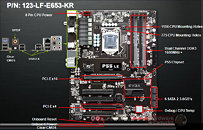- Joined
- Oct 9, 2007
- Messages
- 47,324 (7.51/day)
- Location
- Hyderabad, India
| System Name | RBMK-1000 |
|---|---|
| Processor | AMD Ryzen 7 5700G |
| Motherboard | ASUS ROG Strix B450-E Gaming |
| Cooling | DeepCool Gammax L240 V2 |
| Memory | 2x 8GB G.Skill Sniper X |
| Video Card(s) | Palit GeForce RTX 2080 SUPER GameRock |
| Storage | Western Digital Black NVMe 512GB |
| Display(s) | BenQ 1440p 60 Hz 27-inch |
| Case | Corsair Carbide 100R |
| Audio Device(s) | ASUS SupremeFX S1220A |
| Power Supply | Cooler Master MWE Gold 650W |
| Mouse | ASUS ROG Strix Impact |
| Keyboard | Gamdias Hermes E2 |
| Software | Windows 11 Pro |
Although not as old as someone like ASUS, MSI, Gigabyte, or DFI, in the motherboards scene, EVGA's recent motherboards have shown the company has very quickly matured and can look other companies in the eye, when it comes to enthusiast-grade motherboards for DIY system builders. Recently, the EVGA P55 FTW aka 132-LF-E657 earned some media coverage. The rest of the lineup, top to bottom, includes: P55 Classified 200, P55 FTW 200 (141-LF-E658-KR), P55 SLI (132-LF-E655-KR), P55 LE (123-LF-E653-KR), and the P55 Micro (121-LF-E652-KR).
The P55 Classified 200, and P55 FTW 200 carry nForce 200 bridge chips that make 3-way SLI possible, and faster. While not much is known about the Classified, it intends to roof the lineup with every enthusiast-grade feature available. One of the distinct features include a "Show Volt" panel, that eliminates the need for a multi-meter to physically read voltages. An LED display on the NE corner of the board displays voltages, as the probes connect to various voltage readout points. The P55 FTW 200 features four PCI-E 2.0 x16 slots in all, to support 3-way SLI. It electrical lane arrangement is detailed in the slide below. Like the Classified 200 and P55 FTW, this one supports the EVbot (discussed later).


Without a supplementary bridge chip in place, P55 SLI suits most 2-way SLI setups with two PCI-E 2.0 x16 slots (x8, x8) to drive graphics, and a third one for dedicated PhysX. It gets skimpier with the P55 LE, that should do fine for single graphics card setups, with a second PCI-E x16 (x4) slot that suits PhysX accelerators. Finally, there's the P55 Micro, which, as the name suggests is a micro-ATX board with features similar to the P55 SLI, albeit in a smaller package.


First spotted with the P55 FTW, the EVbot is a gadget similar to ASUS' OC Palm, that provides on the fly overclocking controls outside the system's display and control. The EVbot connects to the motherboard using a special connector on the rear-panel. The connector is only found on the P55 Classified 200, P55 FTW 200, and P55 FTW. A user interface similar to that of a '90s mobile phone lets users control a variety of low-level system settings including voltages and frequencies.

View at TechPowerUp Main Site
The P55 Classified 200, and P55 FTW 200 carry nForce 200 bridge chips that make 3-way SLI possible, and faster. While not much is known about the Classified, it intends to roof the lineup with every enthusiast-grade feature available. One of the distinct features include a "Show Volt" panel, that eliminates the need for a multi-meter to physically read voltages. An LED display on the NE corner of the board displays voltages, as the probes connect to various voltage readout points. The P55 FTW 200 features four PCI-E 2.0 x16 slots in all, to support 3-way SLI. It electrical lane arrangement is detailed in the slide below. Like the Classified 200 and P55 FTW, this one supports the EVbot (discussed later).


Without a supplementary bridge chip in place, P55 SLI suits most 2-way SLI setups with two PCI-E 2.0 x16 slots (x8, x8) to drive graphics, and a third one for dedicated PhysX. It gets skimpier with the P55 LE, that should do fine for single graphics card setups, with a second PCI-E x16 (x4) slot that suits PhysX accelerators. Finally, there's the P55 Micro, which, as the name suggests is a micro-ATX board with features similar to the P55 SLI, albeit in a smaller package.


First spotted with the P55 FTW, the EVbot is a gadget similar to ASUS' OC Palm, that provides on the fly overclocking controls outside the system's display and control. The EVbot connects to the motherboard using a special connector on the rear-panel. The connector is only found on the P55 Classified 200, P55 FTW 200, and P55 FTW. A user interface similar to that of a '90s mobile phone lets users control a variety of low-level system settings including voltages and frequencies.

View at TechPowerUp Main Site
Last edited:



 .
.
 Just sold it though
Just sold it though

 Those things are horrid, bend the mobo like no other and require inhumane strength to push the pins in place. I'll take third party heatsink with a backplate, even heavy one, any day over stock cooler
Those things are horrid, bend the mobo like no other and require inhumane strength to push the pins in place. I'll take third party heatsink with a backplate, even heavy one, any day over stock cooler